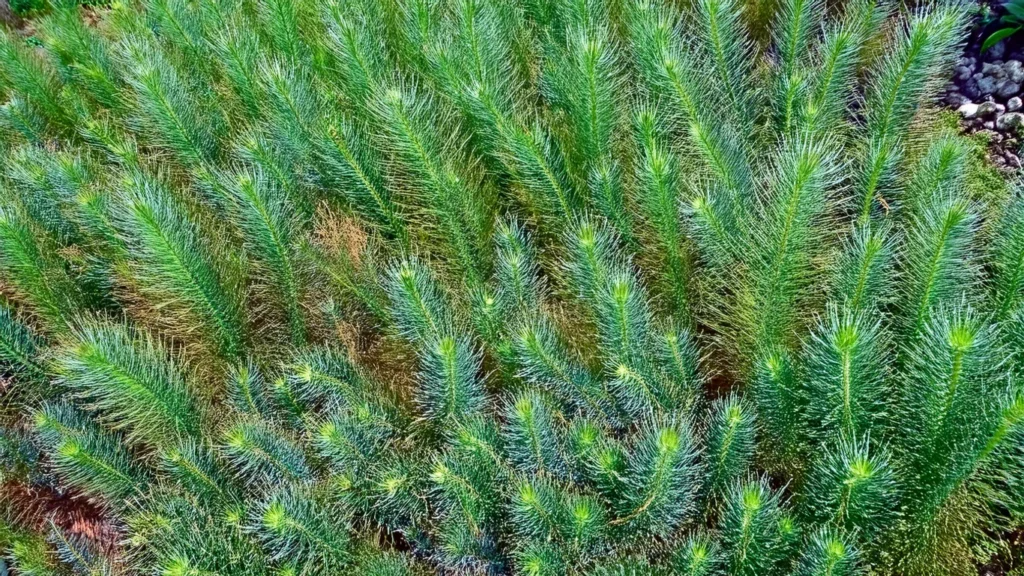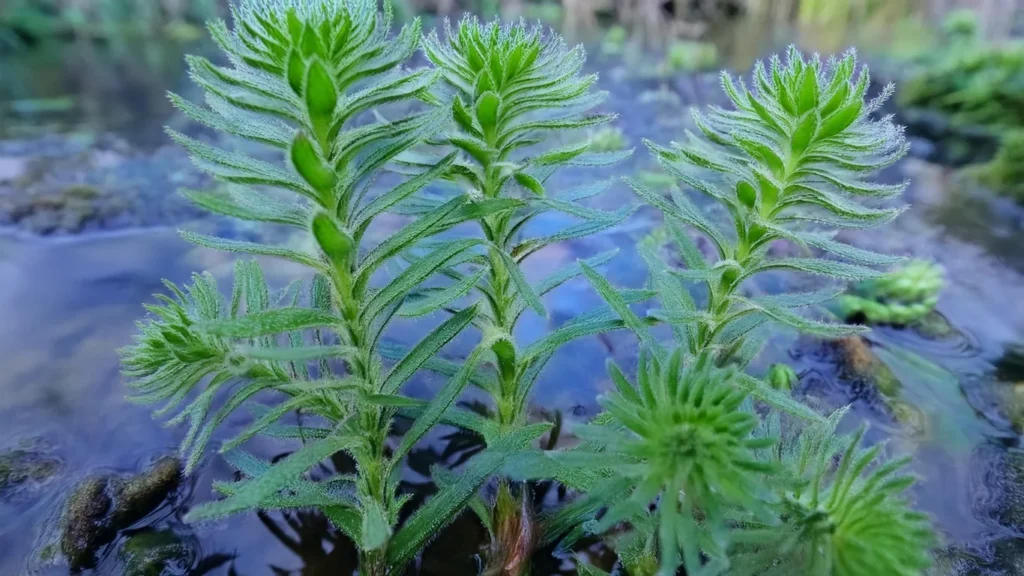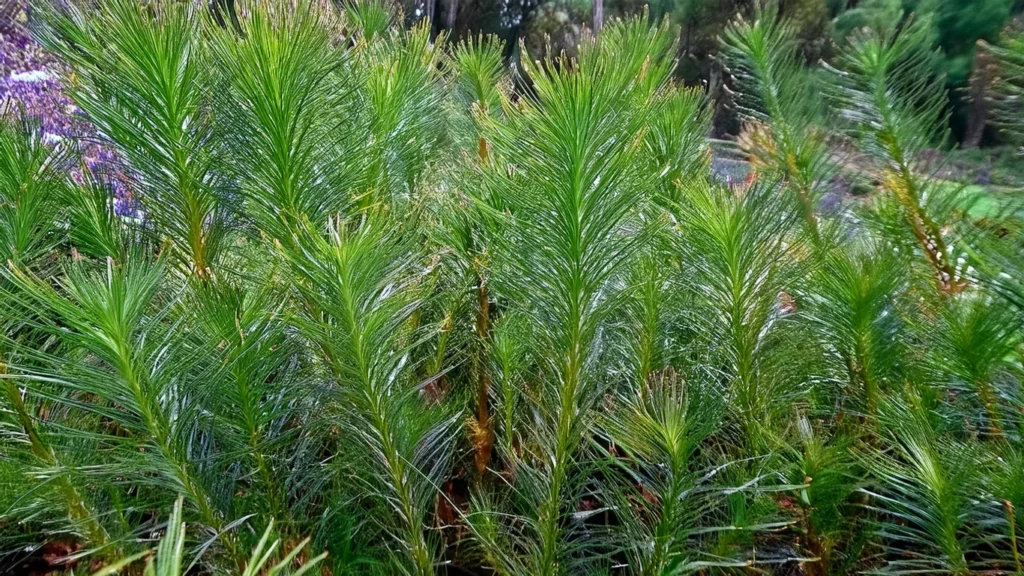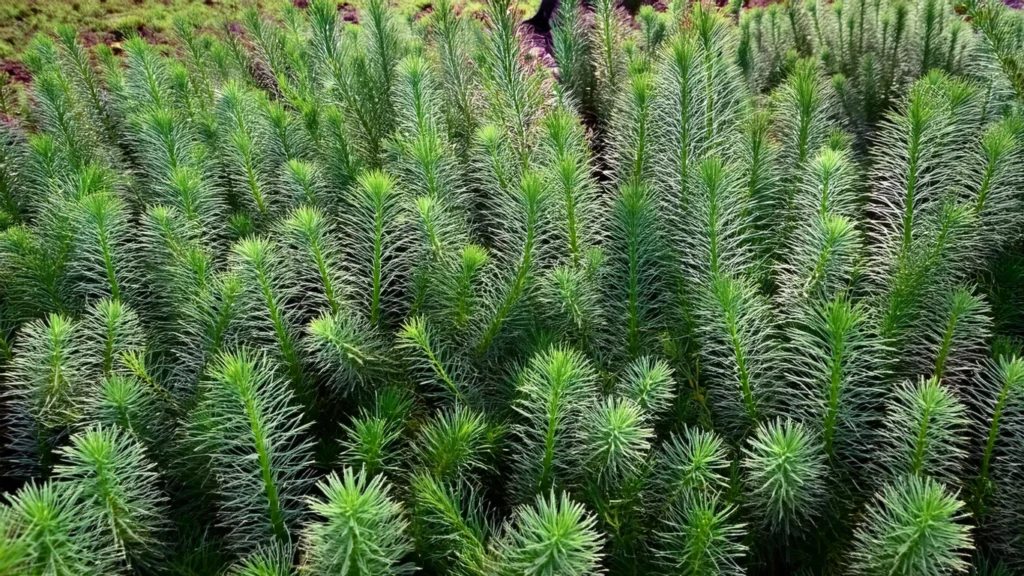Welcome to our comprehensive guide to Myriophyllum Aquaticum and its role in landscape design.
Myriophyllum Aquaticum, commonly known as water milfoil, is a versatile and visually appealing aquatic plant that has become increasingly popular in water garden landscaping and pond design.
Its vibrant foliage and unique growth pattern make it an excellent choice for creating dynamic and aesthetically pleasing aquatic environments.
In this guide, we will explore the origins and cultivation of Myriophyllum Aquaticum, its impact on ecosystems, its care requirements, and its integration into landscape design.
Whether you are a beginner looking to incorporate this plant into your water garden or an experienced landscaper seeking new ideas, we have you covered. Let’s dive in!

Key Takeaway
- Myriophyllum Aquaticum, also known as water milfoil, is a popular aquatic plant for landscape design.
- It adds vibrancy and visual interest to water gardens and pond landscapes.
- Understanding its origins, cultivation preferences, and care requirements is crucial for successful integration.
- Myriophyllum Aquaticum can positively and negatively impact ecosystems, making responsible management essential.
- By following proper cultivation techniques and design principles, you can create stunning and functional water gardens with Myriophyllum Aquaticum.
Quick Stats
| Attribute | Details |
| Family Name | Haloragaceae |
| Origin | South America |
| Height | 20-60 cm (8-24 inches) above the water surface |
| pH Range | 6.0 – 7.5 |
| CO2 Requirement | Low |
| Growth Rate | Fast |
| Care Level | Easy |
| Color Form | Bright Green |
| Water Conditions | 18-26°C (64-79°F), adaptable to a wide range of water hardness |
| Max Size | Can grow several inches above the water surface, with submerged portions reaching further down |
| Lighting | Moderate to High |
| Supplements | Benefits from nutrient-rich water, but not strictly necessary |
| Placement | Background or Pond/Aquarium Surface |
| Propagation | Stem cuttings that easily root |
What Is Myriophyllum Aquaticum?
Myriophyllum Aquaticum, commonly known as water milfoil, is an aquatic plant that belongs to the Haloragaceae family.
It is native to South and Central America and has become widely distributed across the United States and other parts of the world.
This plant is highly valued for its attractive feathery foliage and its ability to enhance the aesthetics of water gardens, ponds, and other aquatic landscapes.
Origins And Introduction To The US
- Myriophyllum Aquaticum was first introduced to the United States in the 1940s as an ornamental plant. It quickly gained popularity due to its striking appearance and adaptability to various aquatic environments.
- The plant was commonly used in water gardens and aquariums, and in some cases, it escaped into natural water bodies, where it established itself as an invasive species.

Cultivation And Preferred Habitats
- Myriophyllum Aquaticum thrives in various aquatic habitats, including lakes, ponds, streams, and marshes. It prefers still or slow-moving water with moderate to high nutrient levels.
- The plant requires full or partial sunlight to grow and is known for tolerating a wide range of water temperatures. Proper cultivation techniques and regular maintenance are essential for ensuring the healthy growth of Myriophyllum Aquaticum in water gardens and other aquatic landscapes.
RELATED: Exploring Beauty And Versatility Of Anubias Nangi In Aquascapes
Lighting Demands
- Photosynthesis: Parrot’s Feather is a fast-growing stem plant that relies heavily on photosynthesis for its growth and development. Adequate lighting is essential to ensure that the plant receives sufficient light energy to fuel this process effectively.
- Intensity Requirement: It prefers moderate to high-intensity lighting to thrive. This means providing lighting fixtures with sufficient power output to penetrate through the water column and reach the lower parts of the plant where photosynthesis occurs.
- Light Spectrum: Parrot’s Feather benefits from a balanced spectrum of light, including both blue and red wavelengths. Blue light promotes compact growth and lush foliage, while red light encourages flowering and overall plant health.
- Duration of Light: Like most aquatic plants, Parrot’s Feather benefits from a consistent photoperiod, typically around 8 to 10 hours of light per day. This mimics natural daylight cycles and provides the plant with enough time for photosynthesis while allowing for periods of darkness for respiration and recovery.
Temperature Parameter For Growth
Myriophyllum aquaticum, commonly known as Parrot’s Feather, grows well within a temperature range of 18-28°C (64-82°F).
Maintaining water temperatures within this range is optimal for its growth and overall health in the aquarium.
However, it can tolerate slightly lower or higher temperatures for short periods.
Consistency in temperature is more important than the exact value, as abrupt fluctuations can stress the plant.
Optimal Water Condition
- pH Level: Ideally, the pH should be slightly acidic to neutral, ranging from 6.5 to 7.5. Parrot’s Feather can tolerate a slightly wider pH range, but maintaining it within this range is best for optimal growth.
- Water Hardness: Parrot’s Feather prefers moderately hard to soft water, with a general hardness (GH) of 4-12 dGH and carbonate hardness (KH) of 3-8 dKH. However, it can adapt to a wide range of water hardness levels.
- Temperature: Maintain water temperatures between 18-28°C (64-82°F). Consistency in temperature is crucial, as abrupt fluctuations can stress the plant.
- Light: Provide moderate to high-intensity lighting to ensure adequate photosynthesis. Parrot’s Feather benefits from a balanced spectrum of light, including both blue and red wavelengths.
- Nutrient Levels: Ensure that essential nutrients such as nitrogen, phosphorus, and potassium are available in the water column. Regular fertilization with a comprehensive liquid fertilizer or root tabs can supplement nutrients for healthy growth.

Substrate Requirement
- Nutrient-Rich Substrate: Use a substrate that contains nutrients to support plant growth. Options include nutrient-rich aquarium soil or substrate additives like clay-based substrates or laterite. These substrates provide essential nutrients for root uptake and promote healthy growth.
- Depth: Parrot’s Feather has a shallow root system, so a substrate depth of 1-2 inches (2.5-5 cm) is generally sufficient. Deeper substrates may not be necessary unless you have other plants with deeper roots.
- Texture: The substrate texture can vary from fine sand to gravel. Parrot’s Feather can anchor its roots in most substrates, so choose one that suits your aesthetic preferences and the needs of other plants in your aquarium.
- Aeration: Ensure good substrate aeration to prevent anaerobic conditions that can lead to the production of toxic gases. You can achieve this by occasionally stirring the substrate during water changes or using substrate aerators.
Placement Options
- Background Plant: Parrot’s Feather can be placed in the background of the aquarium, where its tall stems and lush foliage create a striking visual backdrop. This placement adds depth to the aquascape and complements foreground and midground plants.
- Midground Accent: Alternatively, Parrot’s Feather can serve as a midground accent plant, especially in larger aquariums. Placing it amidst other aquatic plants adds texture and dimension to the midground, enhancing the overall aesthetic appeal.
- Floating Plant: Parrot’s Feather is well-suited for floating placement, where its stems and foliage create a beautiful floating canopy. Floating Parrot’s Feather provides shade and shelter for fish and other inhabitants, reducing glare and creating a natural-looking habitat.
- Aquarium Borders: Parrot’s Feather can also be used to line the edges or borders of the aquarium. This placement adds a soft, feathery texture to the aquarium perimeter, framing the aquatic landscape and concealing equipment or unsightly edges.

Recommended Tank Size
- Growth Habit: Parrot’s Feather is a fast-growing plant that can quickly spread and fill available space in the aquarium. Therefore, it’s essential to choose a tank size that allows ample room for its growth without overcrowding other plants or inhabitants.
- Placement: If using Parrot’s Feather as a background plant or midground accent, consider a larger tank size to accommodate its tall stems and lush foliage. A tank with dimensions of at least 20 gallons (75 liters) or larger is suitable for creating a visually appealing backdrop or midground feature.
- Aquascape Design: The size of the tank should align with the desired aquascape design and overall layout. For densely planted aquariums or aquascapes with multiple layers of vegetation, a larger tank provides more space for arranging plants and creating depth and perspective.
- Compatibility: Consider the compatibility of Parrot’s Feather with other aquatic plants and tank inhabitants. In larger tanks, there’s more space to introduce a variety of plant species and aquatic life, allowing for a diverse and balanced ecosystem.
Complementary Plants For Myriophyllum Aquaticum
- Water Lilies: These iconic aquatic plants offer stunning blooms and share similar water requirements with Myriophyllum Aquaticum. They provide additional shade and aesthetic beauty to your pond.
- Cattails: Known for their tall, slender stalks and distinctive cylindrical flower spikes, cattails create vertical interest and serve as natural filters. They complement the lush foliage of Myriophyllum Aquaticum.
- Water Irises: With their vibrant colors and lush foliage, water irises add visual interest and texture to your pond. They thrive in similar growing conditions and create a harmonious backdrop for Myriophyllum Aquaticum.
- Pickerelweed: This perennial plant features striking blue-purple flowers and broad, lance-shaped leaves. It complements the growth habit of Myriophyllum Aquaticum and provides a burst of color and texture to your water garden.
Nutritional Needs Of The Plant
- Macronutrients: Parrot’s Feather requires essential macronutrients such as nitrogen (N), phosphorus (P), and potassium (K) for healthy growth. These nutrients can be supplied through regular water changes, fish waste, and the use of aquarium fertilizers specifically formulated for aquatic plants.
- Micronutrients: In addition to macronutrients, Parrot’s Feather also requires micronutrients including iron (Fe), magnesium (Mg), calcium (Ca), and others. These micronutrients are vital for various physiological processes such as photosynthesis, enzyme activation, and overall plant health.
- Carbon Dioxide (CO2): While Parrot’s Feather can grow in low to moderate light conditions, supplementing carbon dioxide (CO2) can enhance its growth and vibrancy. CO2 injection or liquid carbon supplements can be beneficial, especially in high-light setups or densely planted aquariums.
- Light: Adequate lighting is crucial for Parrot’s Feather to thrive. Provide moderate to high-intensity lighting (around 2 to 4 watts per gallon) to support healthy photosynthesis and lush growth. LED or fluorescent aquarium lights with a color temperature in the range of 5000K to 7000K are suitable for promoting optimal growth.

Myriophyllum Aquaticum Cultivation Tips
- Lighting: Parrot’s Feather thrives in moderate to high lighting conditions. Provide at least 2 to 4 watts per gallon of full-spectrum lighting for optimal growth. LED or fluorescent aquarium lights with a color temperature in the range of 5000K to 7000K are suitable.
- Water Parameters: Maintain stable water parameters conducive to aquatic plant growth. Ideal conditions include a temperature range of 20-28°C (68-82°F), pH between 6.5 and 7.5, and water hardness (dH) of 5-15°. Regular water changes and proper filtration are essential for water quality.
- Substrate: While Parrot’s Feather can grow in various substrates, it prefers nutrient-rich substrates such as aquatic plant substrates or fine gravel. Ensure good substrate depth for root anchorage and nutrient uptake.
- Nutrients: Parrot’s Feather absorbs nutrients primarily through its stems and foliage. Supplement with liquid or substrate fertilizers containing essential macro and micronutrients to promote healthy growth. CO2 supplementation can also enhance growth, especially in high-light setups.
- Pruning: Regular pruning is essential to control the growth of Parrot’s Feather and prevent it from overshadowing other plants in the aquarium. Trim overgrown stems and remove any debris or decaying plant matter to maintain water quality.
- Propagation: Parrot’s Feather propagates readily through stem cuttings. Simply trim healthy stems and replant them in the substrate, ensuring that the nodes are buried to promote new root growth. Regular pruning encourages branching and bushier growth.
Plant Propagation Tips
- Stem Cuttings: One of the most common methods of propagation is through stem cuttings. Simply trim healthy stems from the parent plant using sharp, clean scissors or pruning shears. Make cuts just below a node, which is where roots will emerge.
- Preparation: Before planting the stem cuttings, remove any leaves from the lower portion of the stem to expose the nodes. This encourages better root development. You can also trim the stems to the desired length, but ensure each cutting has at least one node.
- Planting: Insert the stem cuttings into the substrate, ensuring that the nodes are buried. Planting them at an angle can help prevent them from floating. Space the cuttings apart to allow room for growth and prevent overcrowding.
- Root Development: Place the planted stem cuttings in an area of the aquarium with moderate to high light and stable water parameters. Roots should begin to develop from the buried nodes within a few weeks. You may notice new growth appearing above the water surface as well.
- Maintenance: Regularly monitor the propagated stems for signs of growth and root development. Ensure that the water quality remains optimal and consider supplementing with liquid or substrate fertilizers to support growth.

RELATED: The Aquatic Wonder Bacopa Australis To Transform Your Aquascape
Benefits Of Integrating Myriophyllum Aquaticum In Water Gardens
- Enhanced Water Quality: Myriophyllum Aquaticum absorbs excess nutrients, such as nitrogen and phosphorus, from the water, helping to reduce the risk of algae overgrowth and maintain water clarity. This improves the overall water quality in your pond.
- Natural Filtration: The dense foliage of Myriophyllum Aquaticum acts as a natural filter, trapping sediment and suspended particles in the water. This filtration process helps to remove impurities and promote a healthier aquatic environment.
- Shade and Temperature Regulation: The lush foliage of Myriophyllum Aquaticum provides shade and helps regulate water temperature by reducing sunlight penetration. This is especially beneficial for delicate fish and other aquatic inhabitants.
- Protection and Habitat: The dense growth of Myriophyllum Aquaticum offers shelter and protection for aquatic organisms, such as fish fry and beneficial microorganisms. These plants provide hiding places, spawning sites, and foraging areas, supporting a diverse and thriving underwater ecosystem.

Conclusion
Throughout this comprehensive guide, we have explored the fascinating world of Myriophyllum Aquaticum and its role in landscape design, water gardening, and pond landscaping.
We have learned that Myriophyllum Aquaticum, also known as water milfoil, is a versatile and visually appealing aquatic plant with a rich history.
By understanding its origins and preferred habitats, we can better appreciate the characteristics that make Myriophyllum Aquaticum a valuable addition to water gardens.
Its ability to create a balanced aquatic ecosystem and provide numerous benefits to other aquatic plants is invaluable in landscape design.
However, we must be mindful of Myriophyllum Aquaticum’s invasive nature and take proactive measures to prevent its uncontrolled spread.
Responsible cultivation and management practices are crucial to maintaining the ecological balance of our water ecosystems and preserving their natural beauty.
Frequently Asked Questions
How Can I Control The Growth Of Myriophyllum Aquaticum?
The growth of Myriophyllum Aquaticum can be controlled through various methods, including physical removal, chemical control measures, and the use of biological control options.
These methods should be employed with caution and in accordance with local regulations to prevent harm to other aquatic species or the environment.
What Legal And Environmental Considerations Should I Be Aware Of When Dealing With Myriophyllum Aquaticum?
It is important to check for any specific regulations or restrictions related to the cultivation, management, or disposal of Myriophyllum Aquaticum in your region.
Additionally, it is crucial to consider the potential environmental impact of this invasive species and practice responsible cultivation and management to prevent its spread.
How Can I Propagate Myriophyllum Aquaticum?
Myriophyllum Aquaticum can be propagated through various methods, including the stem-cutting method.
To propagate this plant, take healthy cuttings of the stems and submerge them in water until they develop roots.
Once roots have formed, the cuttings can be planted in a suitable substrate or transplanted into the desired location.
What Are Some Common Challenges That Arise When Growing Myriophyllum Aquaticum?
Some common challenges when growing Myriophyllum Aquaticum include managing its growth and preventing its spread to natural water bodies, controlling its invasiveness, and maintaining a balanced aquatic ecosystem.
These challenges can be overcome through proper care, regular maintenance, and responsible cultivation practices.
How Can I Design A Visually Appealing Water Garden With Myriophyllum Aquaticum?
To design a visually appealing water garden with Myriophyllum Aquaticum, consider contrasting textures and colors by incorporating other aquatic plants and features.
Create focal points by strategically placing the Parrot Feather plant within the water garden.
Additionally, design naturalistic pond landscapes by incorporating rocks, driftwood, or other elements to create a more organic look and feel.
- Unveiling The Wonders Of Riccia Fluitans In Aquascapes - August 7, 2024
- Vallisneria Gigantea Var. Guide To Care And Cultivation At Home - July 31, 2024
- Vesicularia Dubyana Care & Growth Guide Tips For Beginner Gardeners - July 30, 2024
